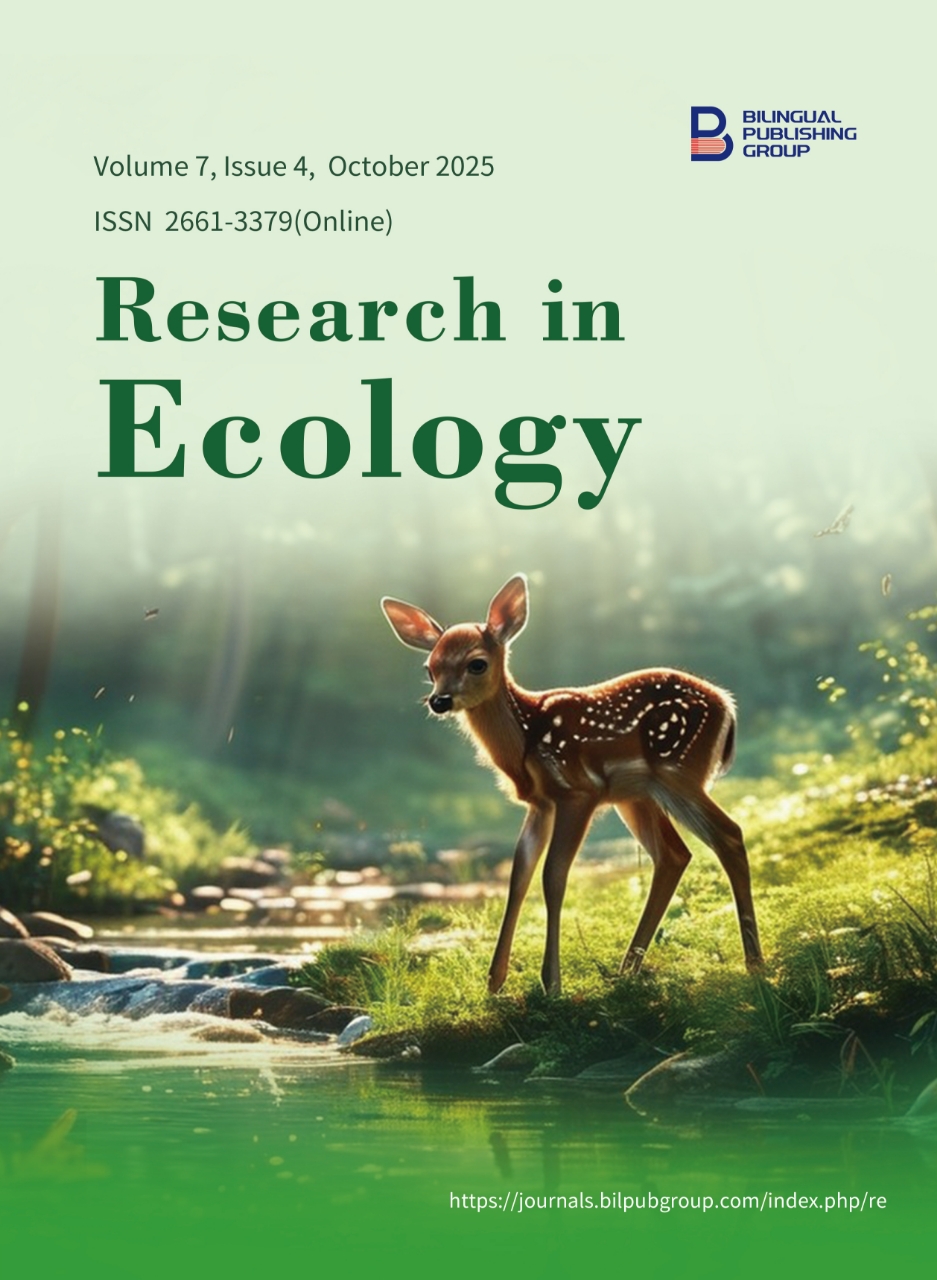
Evaluation of the Concentration of Radon in a Single-family House in a Province Northwest of Madrid
DOI:
https://doi.org/10.30564/re.v7i4.10549Abstract
Indoor radon concentrations have become a significant health concern due to their long-term deleterious effects on the lungs. Radon exposure is a leading cause of lung cancer, especially among non-smokers, making it critical to understand the risk factors associated with radon presence. This article evaluates radon levels in a single-family house located to the northwest of Madrid. The study was conducted during both summer and winter seasons, which are the predominant periods for this region. The research aims to analyze the varying radon concentrations observed during these seasons, considering factors such as ventilation, seasonal temperature differences, and the specific construction materials used in the house. The accumulation of radon can be influenced by the permeability of the building’s foundation, materials, and the effectiveness of natural ventilation systems. In winter, reduced ventilation can lead to higher radon levels due to the sealing of windows and doors to retain heat, while summer conditions may provide more opportunities for ventilation, potentially reducing concentrations. This study examines how these factors interact, exploring the relationship between indoor air quality and radon levels. Measurements before and after ventilation renewal are included to assess any changes in radon concentrations. The findings aim to provide a better understanding of the behavior of radon in residential settings and offer practical recommendations for mitigating its health risks, especially in homes with poor ventilation and specific construction characteristics. Ultimately, the results could guide strategies for improving indoor air quality and reducing radon exposure in similar homes.
Keywords:
Construction Materials; Indoor Air Quality; Health Concern; Radon Exposure and VentilationReferences
[1] Bossew, P., 2017. Local probability of indoor radon concentration to exceed the threshold estimated from geogenic radon potential. Nuclear Technology and Radiation Protection. 32(1), 70–76. DOI: https://doi.org/10.2298/NTRP1701070B
[2] Ciotoli, G., Voltaggio, M., Tuccimei, P., et al., 2017. Geographically weighted regression and geostatistical techniques to construct the geogenic radon potential map of the Lazio region: A methodological proposal for the European Atlas of Natural Radiation. Journal of Environmental Radioactivity. 166(2), 355–375. DOI: https://doi.org/10.1016/j.jenvrad.2016.05.010
[3] Petermann, E., Bossew, P., 2021. Mapping indoor radon hazard in Germany: The geogenic component. Science of the Total Environment. 780, 146601. DOI: https://doi.org/10.1016/j.scitotenv.2021.146601
[4] Ennemoser, O., Oberdorfer, E., Brunner, P., et al., 1995. Mitigation of indoor radon in an area with unusually high radon concentrations. Health Physics. 69(2), 227–232. DOI: https://doi.org/10.1097/00004032-199508000-00007
[5] Pol, R., Rodríguez, R., Quindós, L.S., et al., 2022. Measurement and mitigation of radon concentration in a traditional dwelling in Galicia, Spain. Atmosphere. 13(1), 14. DOI: https://doi.org/10.3390/atmos13010014
[6] Lucchetti, C., Galli, G., Tuccimei, P., 2022. Indoor/outdoor air exchange affects indoor radon: The use of a scale model room to develop a mitigation strategy. Advances in Geosciences. 57, 81–88. DOI: https://doi.org/10.5194/adgeo-57-81-2022
[7] Marley, F., Phillips, P.S., 2001. Investigation of the potential for radon mitigation by operation of mechanical systems affecting indoor air. Journal of Environmental Radioactivity. 54(2), 205–219. DOI: https://doi.org/10.1016/s0265-931x(00)00091-6
[8] Jiranek, M., Rovenska, K., Fronka, A., 2008. Radon diffusion coefficient—A material property determining the applicability of waterproof membranes as radon barriers. In Proceedings of the American Association of Radon Scientists and Technologists, Las Vegas, NV, USA, 14–17 September 2008; pp. 1–8. Available from: https://www.researchgate.net/publication/263917846_RADON_DIFFUSION_COPEFFICIENT_-_A_MATERIAL_PROPERTY_DETERMINING_THE_APPLICABILITY_OF_WATERPROOF_MEMBRANES_AS_RADON_BARRIERS
[9] Ruvira, B., García-Fayos, B., Juste, B., et al., 2022. Experimental estimation of the diffusion coefficient in radon barrier materials based on ISO/TS 11665-13:2017. Radiation Physics and Chemistry. 193, 109993. DOI: https://doi.org/10.1016/j.radphyschem.2022.109993
[10] Jiranek, M., Hulka, J., 2000. Radon diffusion coefficient in radon-proof membranes—Determination and applicability for the design of radon barriers. International Journal on Architectural Science. 1(4), 149–155. Available from: https://www.researchgate.net/publication/267935574_Radon_diffusion_coefficient_in_radon-proof_membranes_-_determination_and_applicability_for_the_design_of_radon_barriers
[11] Jiranek, M., Hulka, J., 2001. Applicability of various insulating materials for radon barriers. Science of the Total Environment. 272(1–3), 79–84. Available from: file:///C:/Users/EDY/Downloads/applicabilityofinsulatmat.pdf
[12] Jiranek, M., Kotrbata, M., 2011. Radon diffusion coefficients in 360 waterproof materials of different chemical composition. Radiation Protection Dosimetry. 145(2–3), 178–183. DOI: https://doi.org/10.1093/rpd/ncr043
[13] Milner, J., Shrubsole, C., Das, P., et al., 2014. Home energy efficiency and radon related risk of lung cancer: Modelling study. BMJ. 348, 1–12. DOI: https://doi.org/10.1136/bmj.f7493
[14] Somsunun, K., Prapamontol, T., Pothirat, C., et al., 2022. Estimation of lung cancer deaths attributable to indoor radon exposure in upper northern Thailand. Scientific Reports. 12(1), 5169. DOI: https://doi.org/10.1038/s41598-022-09122-y
[15] European Commission, 2014. Council Directive 2013/59/Euratom. The Council of the European Union: Brussels, Belgium. Available from: https://www.legislation.gov.uk/eudr/2013/59/contents
[16] Bochicchio, F., Venoso, G., Antignani, S., et al., 2017. Radon reference levels and priority areas considering optimisation and avertable lung cancers. Radiation Protection Dosimetry. 177(1–2), 87–90. DOI: https://doi.org/10.1093/rpd/ncx130
[17] Miles, J.C., 2001. Temporal variation of radon levels in houses and implications for radon measurement strategies. Radiation Protection Dosimetry. 93(4), 369–375. DOI: https://doi.org/10.1093/oxfordjournals.rpd.a006449
[18] Bartzis, J., Arvela, H., Bochicchio, F., et al., 2012. Radon prevention and remediation: The RADPAR Recommendations. University of Western Macedonia: Kozani, Greece. DOI: http://dx.doi.org/10.13140/RG.2.2.12952.08964
[19] Baysson, H., Billon, S., Laurier, D., et al., 2003. Seasonal correction factors for estimating radon exposure in dwellings in France. Radiation Protection Dosimetry. 104(3), 245–252. DOI: https://doi.org/10.1093/oxfordjournals.rpd.a006188
[20] Burke, O., Long, S., Murphy, P., et al., 2010. Estimation of seasonal correction factors through Fourier decomposition analysis: A new model for indoor radon levels in Irish homes. Journal of Radiological Protection. 30(3), 443. DOI: https://doi.org/10.1088/0952-4746/30/3/002
[21] Kozak, K., Mazur, J., Kozlowska, B., et al., 2011. Correction factors for determination of annual average radon concentration in dwellings of Poland resulting from seasonal variability of indoor radon. Applied Radiation and Isotopes. 69(10), 1459–1465. DOI: https://doi.org/10.1016/j.apradiso.2011.05.018
[22] Miles, J.C., Howarth, C.B., Hunter, N., 2012. Seasonal variation of radon concentrations in UK homes. Journal of Radiological Protection. 32(3), 275–287. DOI: https://doi.org/10.1088/0952-4746/32/3/275
[23] Bochicchio, F., Campos-Venuti, G., Piermattei, S., et al., 2005. Annual average and seasonal variations of residential radon concentration for all the Italian regions. Radiation Measurements. 40(2–6), 686–694. DOI: https://doi.org/10.1016/j.radmeas.2004.12.023
[24] Friedmann, H., 2005. Final results of the Austrian radon project. Health Physics. 89(4), 339–348. DOI: https://doi.org/10.1097/01.hp.0000167228.18113.27
[25] Gammage, R., Dudney, C., Wilson, D., et al., 1992. Subterranean transport of radon and elevated indoor radon in hilly karst terrains. Atmospheric Environment Part A: General Topics. 26(12), 2237–2246. DOI: https://doi.org/10.1016/0960-1686(92)90413-F
[26] Li, X., Zheng, B., Wang, Y., 2006. A study of daily and seasonal variations of radon concentrations in underground buildings. Journal of Environmental Radioactivity. 87(1), 101–106. DOI: https://doi.org/10.1016/j.jenvrad.2005.11.002
[27] Moreno, V., Bach, J., Font, L., 2016. Soil radon dynamics in the Amer fault zone: an example of very high seasonal variations. Journal of Environmental Radioactivity. 151(1), 293–303. DOI: https://doi.org/10.1016/j.jenvrad.2015.10.018
[28] Mose, D.G., Mushrush, G.W., Saiway, G., 2006. Summer indoor radon exceeds winter indoor radon. Proceedings of the Annual International Conference on Soils, Sediments, Water and Energy. 11(1). Available from: https://hdl.handle.net/20.500.14394/43502
[29] Sundal, A.V., Jensen, C.L., Anestad, K., 2007. Anomalously high radon concentrations in dwellings located on permeable glacial sediments. Journal of Radiological Protection. 27(3), 287–298. DOI: https://doi.org/10.1088/0952-4746/27/3/003
[30] Wilson, D., Gammage, R., Dudney, C., 1991. Summertime elevation of 222Rn levels in Huntsville, Alabama. Health Physics. 60(2), 189–197. DOI: https://doi.org/10.1097/00004032-199102000-00006
[31] Sundal, A.V., Henriksen, H., Lauritzen, S.E., 2004. Geological and geochemical factors affecting radon concentrations in dwellings located on permeable glacial sediments: a case study from Kinsarvik, Norway. Environmental Geology. 45(6), 843–858. DOI: https://doi.org/10.1007/s00254-003-0944-5
[32] World Health Organization, 2009. Handbook on Indoor Radon: A Public Health Perspective. World Health Organization: Geneva, Switzerland. Available from: https://www.who.int/publications/i/item/9789241547673
[33] Darby, S., Hill, D., Auvinen, A., et al., 2005. Radon in homes and risk of lung cancer: Collaborative analysis of individual data from 13 European case-control studies. BMJ. 330, 223. DOI: https://doi.org/10.1136/bmj.38308.477650.63
[34] Thomas, J., 2003. Noble Gases. Cavendish Square Publishing: New York, NY, USA.
[35] Cinelli, G., De Cort, M., Tollefsen, T., 2019. European Atlas of Natural Radiation. Publications Office of the European Union: Luxembourg City, Luxembourg. DOI: https://dx.doi.org/10.2760/46388
[36] Akerblom, G., Wilson, C., 1982. Radon—Geological aspects of an environmental problem: Environmental radon investigation in Sweden—Regional environmental documentation of natural radiation in Sweden. Available from: https://www.osti.gov/biblio/6493816 (cited 20 April 2022).
[37] National Research Council, 1999. Risk Assessment of Radon in Drinking Water. National Academies Press: Washington, D.C., USA. DOI: https://doi.org/10.17226/6287
[38] National Council of Radiation Protection and Measurements, 2015. Ionizing radiation exposure of the population of the United States. Report No. 160. National Council of Radiation Protection and Measurements: Bethesda, MD, USA. Available from: https://ncrponline.org/shop/reports/report-no-160-ionizing-radiation-exposure-of-the-population-of-the-united-states/ (cited 20 April 2022).
[39] Schüz, J., Espina, C., Villain, P., et al., 2015. European Code Against Cancer. 12 ways to reduce your cancer risk. Cancer Epidemiology. 39(Suppl. S1), S1–S10. DOI: https://doi.org/10.1016/j.canep.2015.05.009
[40] Akerblom, G., 1987. Investigations and mapping of radon risk areas. Available from: https://pascal-francis.inist.fr/vibad/index.php?action=getRecordDetail&idt=7366219 (cited 20 April 2022).
[41] Aakerblom, G., 1999. Radon legislation and national guidelines. Available from: https://inis.iaea.org/search/search.aspx?orig_q=RN:31004182 (cited 20 April 2022).
[42] Tollefsen, T., Cinelli, G., Bossew, P., 2014. From the European Indoor Radon Map towards an atlas of natural radiation. Radiation Protection Dosimetry. 162(1–2), 129–134. DOI: https://dx.doi.org/10.1093/rpd/ncu244
[43] Bossew, P., 2019. Radon regulation and research in Europe: Is it relevant for the Asian-Pacific region? Available from: http://metroradon.eu/wp-content/uploads/2019/12/Bossew_Singapore2019_1.pdf (cited 20 April 2022).
[44] Ettinger, D.S., Wood, D.E., Aisner, D.L., et al., 2021. NCCN guidelines insights: Non–small cell lung cancer, version 2.2021: Featured updates to the NCCN guidelines. Official Journal of the National Comprehensive Cancer Network. 19(3), 254–266. DOI: https://doi.org/10.6004/jnccn.2021.0013
[45] Scivyer, C.R., 2015. Radon: Guidance on protective measures for new buildings. HIS, BRE Press: Bracknell, UK.
[46] Jose Manuel Valero SL, 2024. Valero. Available from: https://www.grupovalero.com/ (cited 31 October 2024).
[47] Weather Spark, n.d. Summer weather in Collado Villalba, Spain. Available from: https://es.weatherspark.com/s/35506/1/Tiempo-promedio-en-el-verano-en-Collado-Villalba-Espa%C3%B1a (cited 20 April 2022).
[48] González-Lezcano, R.A., Hormigos-Jiménez, S., 2016. Energy saving due to natural ventilation in housing blocks in Madrid. IOP Conference Series: Materials Science and Engineering. 138, 012002. DOI: https://doi.org/10.1088/1757-899X/138/1/012002
[49] del Ama Gonzalo, F., Sanglier Contreras, G., López Fernández, E.J., et al., 2024. Indoor air quality monitoring in dwellings: Case studies in Madrid, Spain. Journal of Green Building. 19(3), 117–138. DOI: https://doi.org/10.3992/jgb.19.3.117
[50] González-Lezcano, R.A., 2023. Editorial: Design of efficient and healthy buildings. Frontiers in Built Environment. 9, 1210956. DOI: https://doi.org/10.3389/fbuil.2023.1210956
Downloads
How to Cite
Issue
Article Type
License
Copyright © 2025 Melany Isabel Pinilla-Hernandez, Sofia Melero-Tur, Tamar Awad Parada, Roberto Alonso Gonzalez-Lezcano

This is an open access article under the Creative Commons Attribution-NonCommercial 4.0 International (CC BY-NC 4.0) License.




 Melany Isabel Pinilla-Hernandez
Melany Isabel Pinilla-Hernandez






